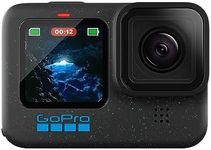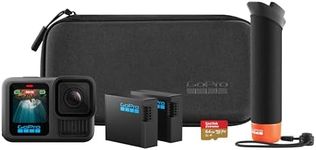Buying Guide for the Best GoPro Cameras
When choosing a GoPro camera, it's important to consider what you'll primarily be using it for. GoPro cameras are known for their durability, compact size, and ability to capture high-quality video and photos in extreme conditions. Whether you're an adventurer, a vlogger, or someone who just wants to capture family moments, understanding the key specifications will help you select the best model for your needs.ResolutionResolution refers to the number of pixels that make up the video or photo. Higher resolution means more detail and clarity. GoPro cameras typically offer resolutions ranging from 1080p to 5K. If you plan to do a lot of editing or want to capture the finest details, a higher resolution like 4K or 5K is ideal. For everyday use or sharing on social media, 1080p or 2.7K might be sufficient. Consider how you will use your footage and where you will display it to determine the right resolution for you.
Frame RateFrame rate is the number of frames captured per second in a video. Common frame rates include 30fps, 60fps, and 120fps. A higher frame rate results in smoother video, especially for fast-moving subjects. If you plan to capture action sports or want to create slow-motion effects, look for a camera that offers higher frame rates like 120fps or 240fps. For standard video recording, 30fps or 60fps is usually adequate. Think about the type of activities you will be filming to choose the appropriate frame rate.
StabilizationStabilization helps reduce the shakiness in your videos, making them look smoother and more professional. GoPro cameras often come with electronic image stabilization, which is crucial for action-packed footage. If you plan to use the camera for activities like biking, skiing, or any movement-heavy sports, prioritize models with advanced stabilization features. For stationary or less dynamic filming, basic stabilization might suffice. Consider how much movement your filming will involve to decide on the level of stabilization you need.
Durability and WaterproofingDurability and waterproofing are key features of GoPro cameras, making them suitable for extreme conditions. Most GoPro models are waterproof without a housing to a certain depth, typically around 10 meters (33 feet). If you plan to use the camera for underwater activities or in harsh environments, ensure it meets your durability and waterproofing needs. For casual use, basic waterproofing might be enough. Assess the environments you'll be filming in to determine the necessary level of protection.
Battery LifeBattery life indicates how long the camera can operate on a single charge. GoPro cameras vary in battery life, often ranging from 1 to 3 hours depending on usage and settings. If you plan to record long sessions or won't have frequent access to charging, look for models with longer battery life or consider purchasing extra batteries. For shorter activities or if you have easy access to charging, standard battery life may be sufficient. Think about your filming duration and charging opportunities to choose the right battery capacity.
ConnectivityConnectivity options, such as Wi-Fi and Bluetooth, allow you to transfer files, control the camera remotely, and share content easily. Most GoPro cameras offer these features, which are useful for quick sharing and remote operation. If you value seamless integration with your smartphone or other devices, ensure the camera has robust connectivity options. For those who prefer manual transfers or don't need remote control, basic connectivity might be adequate. Consider how you plan to manage and share your footage to decide on the necessary connectivity features.







